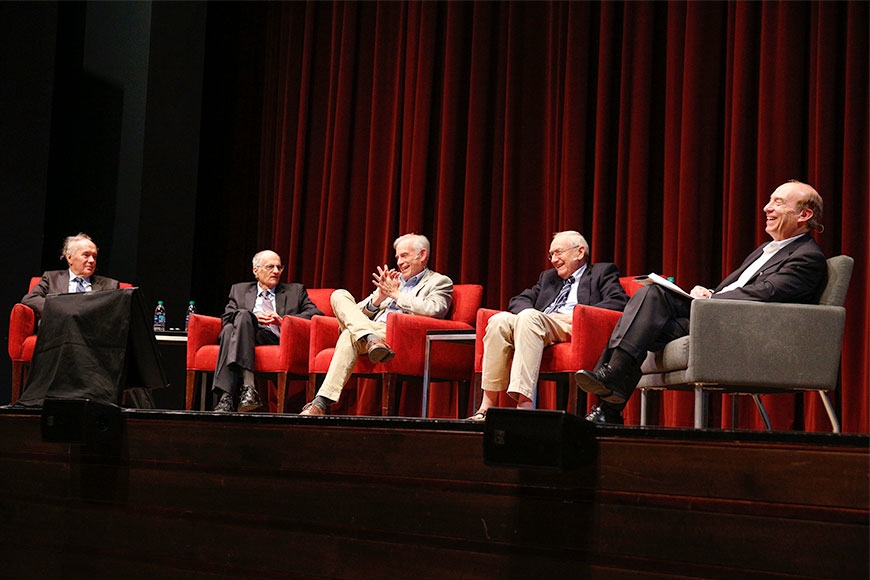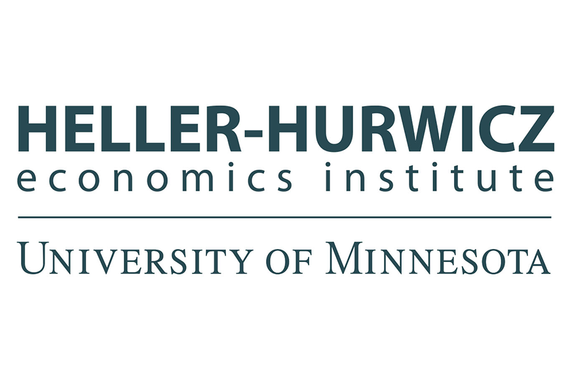The Four Horsemen: A Tale of a 50-Year Partnership
On August 22, 2019, a group of renowned economists—Neil Wallace and Nobel laureates Edward C. Prescott, Thomas J. Sargent, Christopher A. Sims—sat down together on the stage of the Ted Mann Concert Hall with moderator Art Rolnick, a senior fellow at the University’s Humphrey School of Public Affairs, who previously served at the Federal Reserve Bank of Minneapolis as a senior vice president and director of research. The occasion was the celebration of a 50-year partnership between the economics department at the University of Minnesota and the Federal Reserve Bank of Minneapolis, which has, over the years, changed the way research influences national and even global public policy.
50 Years Ago
The economics department of the University of Minnesota was a dynamic place to be in the 1970s and 1980s. It was during this time that Walter Heller, the policy-oriented chair of the Council of Economic Advisers, who served as an adviser to US President John Kennedy, and future Nobel laureate Leonid Hurwicz fostered a relationship between the University’s trailblazing economics department and the policymakers at the Federal Reserve Bank of Minneapolis.
The partnership itself was based on Professor John Kareken’s idea that research should embody policy and that policy can and should influence research. Initially, the intention was to develop better forecasting models and a radical theory of rational expectations. However, the relationship persisted, and the long-term results were groundbreaking research and policy on everything from time consistency to early childhood education, sovereign debt, and distributional inequality.
During this time, Prescott, Sargent, Sims, and Wallace were carving a foundation for the economics department with their innovative research in the field of macroeconomics. Collectively, they were referred to as the “four horsemen.”
Four Horsemen
The term the four horsemen was coined by James Simler, the chair of the economics department in the ‘70s and ‘80s. The name was not a reference to the biblical Four Horsemen of the Apocalypse, but rather was inspired by four University of Notre Dame football players who played under famed coach Knute Rockne in the 1920s, and were known for losing only two games in three years. As such, when referring to Prescott, Sargent, Sims, and Wallace as the four horsemen, Simler was referring to his belief that he was managing a department that contained four formidable scholars who were driving the field of macroeconomics at that time.
In 1970, Kareken recruited Wallace to work on a series of special projects. During his time in the department, Wallace, in collaboration with Kareken, demonstrated how policy and research interact by accurately predicting the savings and loan crisis of the ’80s as well as, according to Rolnick, the financial crisis of 2008.
Wallace went on to challenge the conventional theories of money with research that continues to influence policy around the world today. Shortly after he was recruited, Wallace sought to recruit Sargent, and together these two brilliant minds engaged in research that laid the foundation for the school of thought termed “rational expectations.”
A few years later Sims joined the department and introduced revolutionary models for forecasting the economy that, even today, are still used frequently by econometricians and policymakers.
Prescott joined the department in the early ’80s and went on to win the Nobel Prize in 2004, which he shares with Finn Kydland, a distinguished visiting scholar of the department, for dynamic macroeconomics, time consistency of economic policy, and the driving forces behind the business cycle. In 2011, Sargent and Sims also received the Nobel Prize for their contributions of empirical research on cause and effect in the macroeconomy.
The camaraderie and trust shared by the four panelists are a testament to the bond they developed during their time here and continue to share today. Sims credits the economics department and the Federal Reserve Bank of Minneapolis for this, explaining that “Minnesota—at the time the four of us were here—was just an amazing place. I learned new stuff every day by talking to my colleagues. And my career would not have been what it is if not for those days."
The Promise of an Even Better Tomorrow
Moving forward 50 years to August 2019, more than 200 economists from across the globe convened for a three-day academic conference to commemorate this successful policy–academia collaboration. The event was made particularly special by the presence of the four horsemen themselves, who remain highly revered and beloved (former) faculty members. To this day, they still advise the Federal Reserve Bank of Minneapolis and mentor grad students.
The event was as much about furthering and strengthening this existing relationship as it was about reminiscing, reviewing, and valuing past successes. The panelists spoke at length about trailblazing research, changes in up-and-coming fields and market sections, and the role that Minnesota is already playing in bringing about these changes. Prescott stated, "There's been a revolution in aggregate economics; the place that had the greatest influence in this revolution is Minnesota." Wallace also delved into the impact that cryptocurrency might have on the future of trade. “The unbacked nature of the cryptocurrencies means that every time economists look at this situation, they think that there will be multiple equilibria and that the future value of, say, Bitcoin might become zero,” he warned.
The future of the partnership between the Federal Reserve Bank of Minneapolis and the economics department is today resting in the able hands of driven graduate students and reputed faculty members who continue to refine theories about how research and policy interact. In the years to come, this partnership will continue to foster new ideas and spark policy debates. In the words of College of Liberal Arts’ Dean John Coleman, "This partnership has stood the test of time and has been emulated by many other institutions around the country. This is a partnership that will continue to shape and influence public policy for the next 50 years."
This story was written by an undergraduate student in CLAgency. Meet the team.



